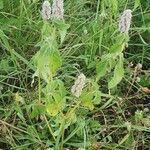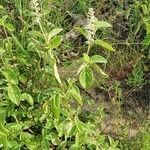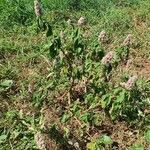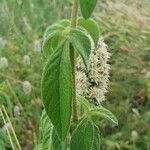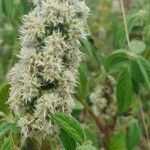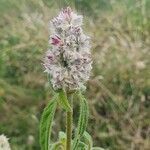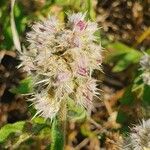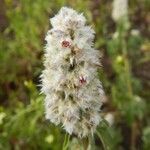Inflorescences white to pale green, crimson or maroon, terminal on the stem and branches, each a spike-like or more rarely capitate thyrse of sessile condensed cymes c. 1.25–2 cm. in diam. at anthesis, the entire thyrse 1.25–8 cm. long with the lowest cymes somewhat distant or not; peduncle 0.6–6 ( 11.5) cm. long, both it and the inflorescence axis whitish-pilose; bracts 3–5 mm. long, lanceolate to deltoid-ovate with a long-excurrent midrib, sparingly to moderately pilose dorsally; bracteoles 3–5 mm., broadly deltoid-ovate, midrib excurrent in a long sharp, straight arista, sparingly pilose dorsally; ultimate divisions of lateral cymes formed of a central fertile flower subtended on each side by a triad of one fertile and two lateral modified flowers.
Outer 2 tepals (3.5)4.5–7(9) mm. long, with 3 very strong and prominent nerves which meet just below the apex and are excurrent to form a short mucro, usually more or less densely furnished with matted, multicellular, barbellate, white hairs, but sometimes thinly hairy or almost glabrous, and then with a carmine colouration frequently developed; inner 3 tepals shorter, more faintly 3–5(6)-nerved with one margin usually wider below and the nerves on that side more widely separated, pilose chiefly about the apex or sometimes throughout; all tepals lanceolate-oblong, narrowly hyaline-margined.
An annual herb. It is erect and has many branches but can also lie along the ground. It grows 1.5 m tall. The stems and branches have white hairs when young. They become angular. The leaves are narrowly oval and vary in shape. They can be 1-15 cm long and 5.5 cm wide. The tip is pointed and it narrows to the base. The flowers can be white to pale green or red. They are near the ends of branches. The flowers are in groups forming rounded heads 4-6 cm wide. The fruit is a small one seeded capsule. These form as a burr about 15. cm across.
Annual herb, usually much-branched, erect to prostrate, commonly straggling or sprawling, 0.3–1.5 m.; stem and branches coarse, terete and striate in the lower parts, becoming bluntly tetragonous or sharply angled and sulcate above, thinly to densely furnished with white, upwardly appressed or patent multicellular hairs, the older parts usually glabrescent; nodes distinctly swollen, usually densely pilose, in larger forms the stem and branches commonly considerably shrunken above the nodes when dry.
Leaves variable in form and size, from broadly ovate to broadly or narrowly elliptic, lanceolate-oblong or narrowly lanceolate, 1–15 × 0.7–5.5 cm., acute or acuminate at the apex, at the base shortly cuneate to attenuate with a petiole 0.4–2 cm. long, surfaces thinly to densely pilose with appressed white hairs which in the more densely hairy forms are longer and more divergent especially along the venation of the lower surface.
In fruit the axis and branches of the lateral cymes become indurate-incrassate and concrescent, so that each cyme falls as a complete burr 1–1.5 cm. in diam. with 4–7 mm. spines; the hard base of the burr clad with the persistent bracteoles.
Filaments compressed, 2.5–5 mm. long; pseudostaminodes 1–2 mm. long, broadly cuneate-obovate, the dentate-fimbriate apex flat or incurved above, a dentate or furcate (“stags-horn”) dorsal scale also present.
Modified flowers of a few lanceolate-based, long-aristate bracteoliform processes and several simple yellowish or reddish spines.
Erect herb, up to 200 mm tall. Leaves ovate to elliptic, pubescent. Inflorescence slightly elongate. Flowers white.
Capsule pyriform, membranous save for the strongly thickened rim around the apical depression, 2.5–3 mm. long.
Style slender, 2–5 mm. long; ovary obovoid-turbinate, c.1–1.5 mm. long.
Seed 2–3 mm., ovoid, brown.
